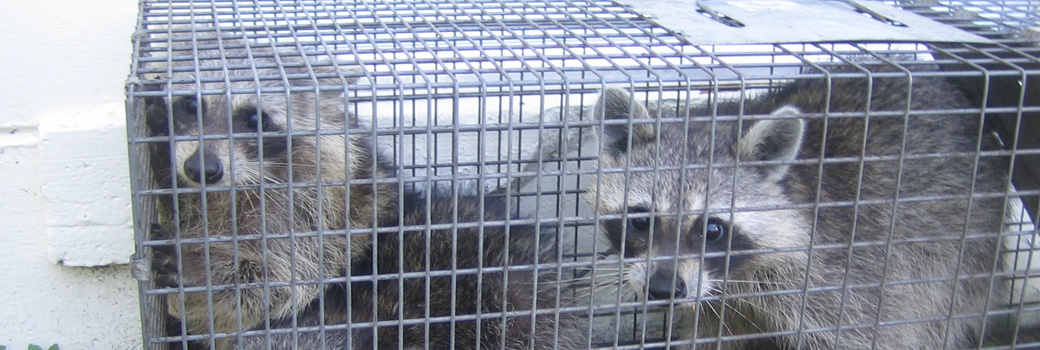- Baltimore Educational Article of the Month - Raccoon trapping: How to trap a Maryland Raccoon
Raccoon trapping: How to trap a Maryland Raccoon
Raccoons are a common mammal native to North America. They are medium sized weighing anywhere from 7-20 lbs. The omnivorousraccoon is nocturnal and can be found digging through your garbage, hiding in your attic and making a mess in and around your home (or campsite). While wise to hire a professional you can trap these pesky critters yourself, if your state allows it. Check with your local and state laws before trapping a raccoon.
Types of traps: Most raccoons are not skittishwhen it comes to traps. However, a raccoon can become “trap shy” if your first attempt at capturing the animal fails. Raccoons are fast learners so it is important to invest in a quality trap that works the first time.Remember that raccoons are nocturnal so you should set up your trap at night.

- Single Cage Traps: Available in two choices, pre-assembled or collapsible, both traps are closed cage walls made of steel where you set bait on the inside of the cage and wait for the animal to enter, once the animal has entered the door flips shut keeping the animal inside. The pre-assembled non collapsible trap is ideal for use at home while the collapsible trap is easy storage and packing making it ideal for camping or hunting. When you are picking a trap make sure it has handles (either on top or on the sides) with a guard on it. The guard should be wide enough to cover your entire hand that way you can pick up and transport the trap, with the Raccoon inside, without risking a bite. A cage trap is humane and ideal if you are looking to release the animal into the wild. Again, check with local laws before using a trap for hunting.
- Double Door Cage Traps: A double ended door trap is more effective than the single door trap and doubles your chances of catching the Maryland raccoon. Like the single door trap the double door trap is the same concept, steel cage walls where bait is placed inside and once the raccoon enters the doors flip closed keeping the animal inside. The double door trap is open on both ends creating what looks like a tunnel to the raccoon, which is less intimidating. Some raccoons will not enter a single cage door because there is no escape on the other side. While more expensive than the single door the double door trap has a higher success rate.
- Leg Traps: One of the oldest types of traps are leg traps. The device is set with bait inside catching the animal by its leg when he goes to reach for the bait. This type of trap is easy to set but highly controversialbecause it is considered inhumaneby some because the animal can break or mangle its leg.Dog Proof Leg Traps are a modern leg trap that is humane, it isa tube style trap that has bait inside, when the raccoon reaches in for the bait it locks its paw inside without injuring it. This style trap is effective and is much safer than the old style JAW traps which break and hold the animal’s leg. Also a dog, cat or child will not be injured by the device if they touch it because their hand will not fit in the trap. Although safer option than the JAW trap it is wise to keep a watchful eye on the trap.
- Body Traps: Body traps(also known as Conibear traps) are a lethal style trap designed to kill the animal quickly. They can be set two ways; open with bait placed inside trapping the animal by its body once it reaches for the food or over a path so when the animal crosses through it. This style trap is extremely dangerous and not as effective as other traps. If you chose to use this style make sure to read the manufacturer’s instructions and exercise caution whileassembling and setting the body trap. Never set a trap where a child or pet could access it!
- Pet food is a great trap bait for a raccoon; but it also might attract your neighbor’s cat.
- Meat is also another great option. However, your dog might get to it first destroying your trap or injuring itself.
- Professional Raccoon Bait- While effective is also unnecessary and expensive.
- One of the most effective bait types are…marshmallows. That’s right, these sweet, fluffy little white candies are perfect size to place inside any of the traps mentioned above and raccoons cannot resist the smell or color (bright white stands out at night).
- Always read manufacturer’s instructions prior to setting the trap
- Trap at night, it is more effective and pets and children will be kept away from the traps!
- Always wear BITE PROOF gloves when handling an animal or picking up a cage trap.
- Raccoons can have Rabies. If bitten, go to your doctor immediately!
- Always check your local laws before attempting to trap a raccoon, trapping is illegal is many states.
- Never attempt to keep a wild animal as a pet.
To learn more about our services, visit the Baltimore wildlife removal home page.

